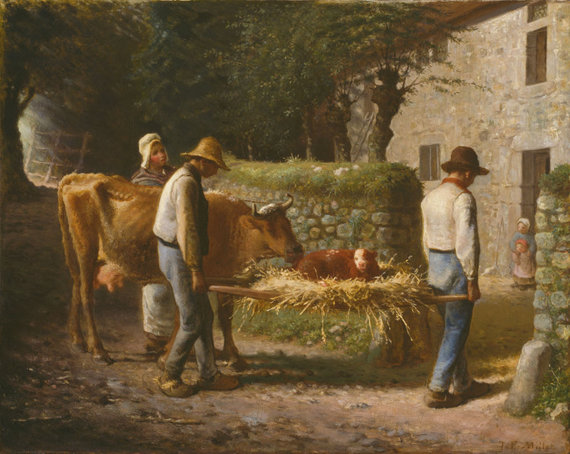Maybe it's the way the light falls, illuminating the bed of straw like some upside-down and disheveled halo, all gold and shimmery, on which the baby lies - a baby cow, in this case. Or maybe it's the calf's beatific face, alert and looking straight out at us from the center of the canvas. I suspect part of it is the posture of the farmer and of his field hand, heads bent, and the care with which they carry the newborn toward the stone cottage (a human home, no doubt about that) and the little girls waiting there. Surely the mother has something to do with it -- a spine-startling cow with skinny legs and modest udder, her head titled just so, her muzzle bumping the calf's rear with that same attention to even the humblest body parts that a baby unashamedly demands. I don't know why the woman is the only one with her mouth open - singing, speaking, calling, assuring...? 
Whatever the case, I can see now why Jean-Francois Millet's "Peasants Bringing Home a Calf Born in the Fields" should look like the Christian nativity to Vincent Van Gogh. I can see why Van Gogh would refer to this by way of a corrective to another painter's traditional "adoration of the shepherds." I doubt that I would have made such an association - this painting of Millet's as a profoundly Christian nativity scene -- without my colleague Clifford Edwards' study of Van Gogh's spirituality, specifically Van Gogh's treatment (or lack) of traditional religious scenes. But learning that is a kind of relief. After all, stare at Millet's painting awhile (if you're lucky enough, in person, at the Art Institute of Chicago), and the association seems inescapable. The painting is startlingly beautiful in exactly the ways of the most poignant Christmas tableau.
Or maybe I'm especially primed to appreciate the connection since I've been thinking a lot lately about Jesus as bigger than Jesus, to include the earth itself. I've wandered away from the church, but I can't seem to let go of it. Is it possible that within the basic tenets of a faith that pivots on the incarnation of God stands a whole new Jesus -a Jesus beyond Jesus that allows as how the nonhuman natural stuff of earth might be as much God's salvific gift of incarnation as the boy-child born some 2,000 years ago at the eastern edge of the Mediterranean?
This question in a variety of permutations nags me. I can't rid myself of the sense that there's something rich and possible buried in the accretions of assumptions, habits of thinking, and reflexive refrains that define modern Christianity. If so, I've got to hand it to the religion of my birth that within its very tradition lie the seeds that undermine that tradition. I'm not interested in argument per se, not in theological wrangling, nor in unseating the Jesus so many people claim to know, so much as simply asking over and over again: what does this mean? and why not?
What does this mean, God's willful incarnation to be among us for reconciliation and love? And why not an enduring incarnation to include the nonhuman natural world of earth itself?
(I.e., why not Millet's calf?) Who is Jesus that the one whom Christians believe to have been from the beginning and alive forevermore could not also be other, be more than the babe from Bethlehem, could not be among us still? What does this mean in the quiet of winter? Why not grace, wonder, and peace all around?